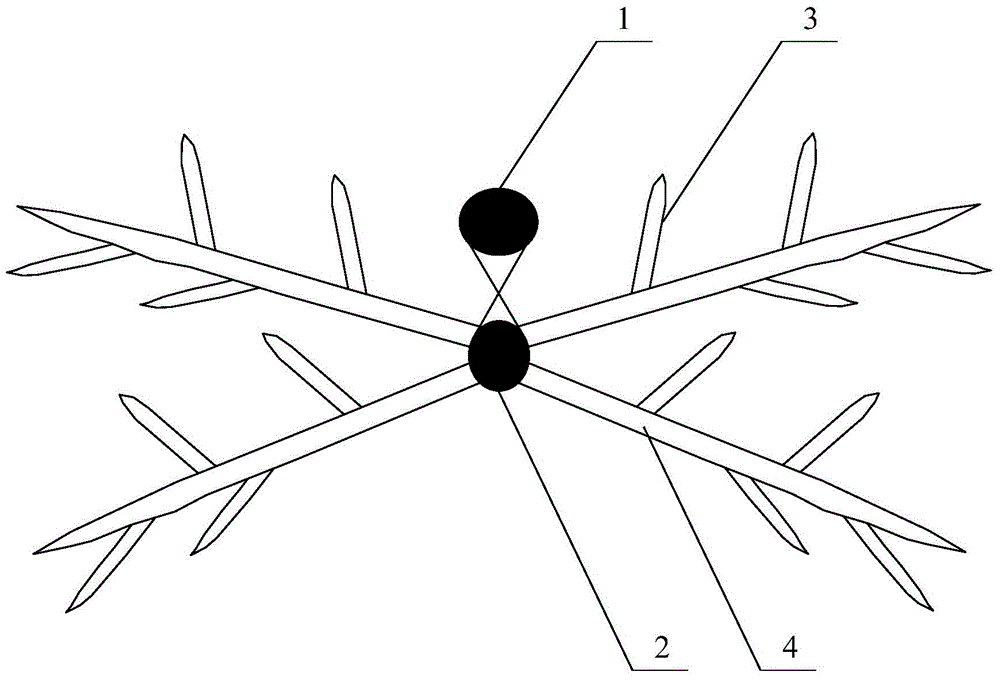A kind of T-shaped wolfberry tree and its cultivation and pruning method
A pruning method and technology of wolfberry, applied in cultivation, application, agriculture, etc., can solve problems such as high labor intensity, and achieve the effects of increased yield, uniform size, and uniform coloring
- Summary
- Abstract
- Description
- Claims
- Application Information
AI Technical Summary
Problems solved by technology
Method used
Image
Examples
Embodiment 1
[0080] S1: Select the land with convenient irrigation, sufficient sunlight, flat terrain, loose soil, and soil thickness greater than 0.8m as the cultivation land, and deeply plow and level the land.
[0081] S2: Divide the cultivation site into several planting rows, and the distance between two adjacent rows of planting rows is 2m. Several cultivation holes are excavated on each row of planting rows to obtain several parts of topsoil and core soil. The distance between the cultivation holes is 0.6m, the length of each cultivation hole is 0.5m, the width is 0.5m, and the depth is 0.5m, and the number of cultivation holes per mu of cultivation land is 550.
[0082] S3: Select several Lycium barbarum seedlings with a trunk length greater than 0.5m and complete fibrous roots greater than 6, and trim the length of each Lycium barbarum seedling to 0.1m to obtain seedlings to be planted.
[0083] S4: Put the seedlings to be planted into the cultivation holes for colonization, and p...
Embodiment 2
[0111] S1: Select the land with convenient irrigation, sufficient sunlight, flat terrain, loose soil, and soil thickness greater than 0.8m as the cultivation land, and deeply plow and level the land.
[0112] S2: Divide the cultivation site into several planting rows. The distance between two adjacent rows of planting rows is 2.3m. Several cultivation holes are excavated on each row of planting rows to obtain several parts of topsoil and core soil. The distance between adjacent cultivation holes is 0.6m, the length of each cultivation hole is 0.5m, the width is 0.5m, and the depth is 0.5m, and the number of cultivation holes per mu of cultivation land is 500.
[0113] S3: Select several Lycium barbarum seedlings whose trunk length is greater than 0.5m and complete fibrous roots are greater than 6, and trim the fibrous root length of each Lycium barbarum seedling to 0.15m to obtain seedlings to be planted.
[0114] S4: Put the seedlings to be planted into the cultivation holes ...
Embodiment 3
[0140] S1: Select the land with convenient irrigation, sufficient sunlight, flat terrain, loose soil, and soil thickness greater than 0.8m as the cultivation land, and deeply plow and level the land.
[0141] S2: Divide the cultivation site into several planting rows. The distance between two adjacent rows of planting rows is 2.8m. Several cultivation holes are excavated on each row of planting rows to obtain several parts of topsoil and core soil. The distance between adjacent cultivation holes is 0.8m, the length of each cultivation hole is 0.5m, the width is 0.5m, and the depth is 0.5m. The number of cultivation holes per mu of cultivation land is 440.
[0142] S3: Select several Lycium barbarum seedlings whose trunk length is greater than 0.5m and complete fibrous roots are greater than 6, and trim the fibrous root length of each Lycium barbarum seedling to 0.12m to obtain seedlings to be planted.
[0143] S4: Put the seedlings to be planted into the cultivation holes for ...
PUM
 Login to View More
Login to View More Abstract
Description
Claims
Application Information
 Login to View More
Login to View More - Generate Ideas
- Intellectual Property
- Life Sciences
- Materials
- Tech Scout
- Unparalleled Data Quality
- Higher Quality Content
- 60% Fewer Hallucinations
Browse by: Latest US Patents, China's latest patents, Technical Efficacy Thesaurus, Application Domain, Technology Topic, Popular Technical Reports.
© 2025 PatSnap. All rights reserved.Legal|Privacy policy|Modern Slavery Act Transparency Statement|Sitemap|About US| Contact US: help@patsnap.com



